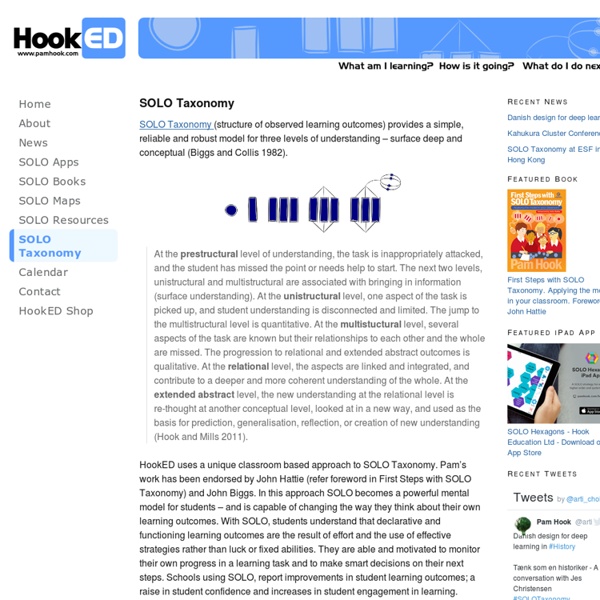SOLO Taxonomy

HOT SOLO Presentations
From HookED Wiki Using SOLO Taxonomy in teaching and learning. Click on an image to download a presentation
Teaching SOLO taxonomy through SOLO taxonomy
When I first started this blog, I was always quite keen to stay away from writing 'How to guides' or give detailed theoretical explanations of particular aspect of learning & teaching. Mainly because there are so many amazing educators out there who have already explained it and probably in a much better way than I ever will. I also like to 'tinker' with ideas and normally what I deliver in my teaching is an adapted version, usually pitched to the students that I learn with. But, I feel I am about to buck the trend and go against my initial aims. I am about to join the dark side! I first read about SOLO in 2009 but at the particular point I wasn't ready in my theory teaching to implement it. So now, back in 2012, I seem to have caught the SOLO bug and went on a big secret trial with my Year 10 & 11 GCSE PE theory groups. So, whatever I do, whether leading sessions for staff or teaching in lessons, I always think 'What could I do that helps people really get what I am talking about'.
SOLO Taxonomy Ppt Presentation
SOLO Taxonomy : SOLO Taxonomy @ Malfroy A Way to Assess Thinking and Get the Kids to Assess Themselves Rationale: : Rationale: We want students to be able to assess their own thinking and be able to move themselves to the next level. We want to be able to assess their thinking for the same reason. Thinking is a key competency. Where to start: : Where to start: The language Put up displays of the rubrics Get your kids using the terminology… they’re never too young! Not just talking the talk : Not just talking the talk So let’s look more carefully at the levels: So how does this work with a topic? So how does this work with a topic? Some other Examples : Some other Examples What we need you to do : What we need you to do Term 2 Put up the display Get your class used to the terminology Design some rubrics Term 3 Plan a unit using the HOT maps – we’ll input more information at another meeting Please remember : Slide 23: Slide 24: SOLO Taxonomy - to help me assess my learning : My understanding of SOLO
SOLO Taxonomy
Prezi used for NQT Network Session 8th Dec’ 2011 SOLO Taxonomy on Prezi Other SOLO Presentations Like this: Like Loading...
Canons Broadside
SOLO Taxonomy « Wilmslow High School's 'Lookout for Learning'
The Structure of Observed Learning Outcome (SOLO) taxonomy is a model of learning that: “Provides a simple and robust way of describing how learning outcomes grow in complexity from surface to deep understanding” Biggs and Collin (1982)Is similar to Bloom’s taxonomy but it has one major advantage: SOLO taxonomy provides a user friendly, common language of learning that enables the student and teacher to explicitly understand the learning process. The 5 levels of understanding are: Pre-structural – The task is not attacked appropriately; the student hasn’t really understood the point and uses too simple a way of going about it.Uni-structural – The student’s response only focuses on one relevant aspect.Multi-structural – The student’s response focuses on several relevant aspects but they are treated independently and additively. To get you started please watch this short video (8 minutes) by David Didau that was filmed at a TeachMeet Clevedon earlier this year: 1. 2. 3. 4. 5. 6. 7.
Hexagonal Learning
The mantra of all successful lesson observations these days is that students should be seen to be making progress. Perhaps the best way to show that you’re having an impact on their knowledge and understanding is to show that the learning is ‘deep’. By that I mean, knowledge that transfers from students’ working memories into their long-term memories. Students understand new ideas by relating them to existing ones. Psychology prof Daniel Willingham‘s advice to teachers is as follows: Provide examples and get students to compare themMake deep knowledge the spoken and unspoken emphasisAccept that shallow knowledge is better than nothing Using SOLO will help address these points: I’ve been grappling with SOLO for some time now and owe a huge debt to Lisa Jane Ashes who has managed to explain it more clearly than anyone else. Why hexagons? You can put whatever you want onto the hexagons, or leave them blank for the kids to fill in. This can work equally well with language analysis. Like this:
iTeachFreely - SOLO Taxonomy 2: usage examples
Despite setting myself the target of writing one post per week, due to a hectic month I have fallen behind. Time to get back on track! This is a very wordy blog post but I hope you find it useful. Recently, I delivered a small section of an INSET day at our school. The INSET was planned and led by the school's 'Pedagogy Leaders', a team of teachers whose task it is to share good practice and promote great pedagogy across the school. I've been very keen to work with the group to improve my own practice and share my ideas. The day was laid out around the school's newly proposed Accelerated Learning Cycle. I felt the day was a great success, with lots of positive feedback received from our colleagues. I think it's important to point out that SOLO can be used in plenty of activities that you may already be doing. To help "SOLO virgins" get started, I'm going to write about a few ways in which I have used SOLO in the classroom. SOLO Stations HOT maps Interacting with GCSE markschemes Planning
Related:
Related:



